Sustainability Assessments of Living Walls in the Mediterranean Area
Abstract
:1. Introduction
- −
- Passive vegetable materials (vegetable fibres, wood, giant reeds, agricultural waste, etc.) [5];
- −
- Living plants (plants, green roofs, living walls, green facades, etc.) [6].
- The built environment, because the implementation of living plants on building facades impacts the summer microclimate by limiting the heat island effects;
- The global environment, due to the attainment of energy saving with a correspondent reduction in greenhouse gas emissions;
- The water urban drainage, because living plants improve the capacity for the retention of rainwater and support the correct management of water drainage;
- Water quality, because the vegetation allows for the removal of pollutants as soluble and insoluble metal traces with a corresponding enhancement of the water drainage quality;
- Biodiversity, because plants can make available an ideal habitat for insects and arthropods, stimulating biodiversity in urban areas;
- Air quality, as vegetation is able to release oxygen to the urban environment absorbing carbon dioxide.
2. Materials and Methods
2.1. Energy Analysis
- Definition of the plan of the building regarding the thermal zone for activity in every space;
- Setting of the thermo-physical characteristics of the materials and definition of the boundary conditions for the building envelope and for the LWs;
- Implementation of an HVAC and other energy devices compliant with the building’s air-conditioning;
2.2. Life Cycle Analysis
3. Results and Discussion
- Global warming (kg CO2e) (GWP);
- Biogenic carbon storage (kg CO2e-bio) (BIO-CO2 storage);
- Ozone depletion (ODP);
- Acidification (AP);
- Eutrophication (EP);
- Formation of ozone in lower atmosphere (POCP);
- Abiotic depletion potential (ADP-elements) for non-fossil resources (ADPE);
- Abiotic depletion potential (ADP-fossil fuels) for fossil resources (ADPF);
- Use of renewable primary resources as raw materials (PERM);
- Total use of renewable primary energy (Primary Energy);
- Total use of non-renewable primary energy (PERT);
- Use of net freshwater (PERNT).
- Foundations (substructure);
- Load-bearing structural frame;
- Non-load-bearing items;
- Façades;
- LWs (excluding vegetable species);
- Roof.
4. Conclusions
Author Contributions
Funding
Data Availability Statement
Conflicts of Interest
References
- European Commission. Energy Performance of Buildings Directive Adopted to Bring down Energy Bills and Reduce Emissions. Available online: https://ec.europa.eu/commission/presscorner/detail/en/ip_24_1965 (accessed on 30 June 2024).
- Fetting, C. The European Green Deal; ESDN Office: Brussels, Belgium, 2020. [Google Scholar]
- Carpino, C.; Bruno, R.; Carpino, V.; Arcuri, N. Uncertainty and Sensitivity Analysis to Moderate the Risks of Energy Performance Contracts in Building Renovation: A Case Study on an Italian Social Housing District. J. Clean. Prod. 2022, 379, 134637. [Google Scholar] [CrossRef]
- Kaitouni, S.I.; Gargab, F.-Z.; Es-sakali, N.; Mghazli, M.O.; Mansouri, F.E.; Jamil, A.; Ahachad, M. Digital Workflow for Nearly Zero-Energy High-Rise Office Building Design Optimization at the District Scale in Mediterranean Context. Energy Built. Environ. 2024. [Google Scholar] [CrossRef]
- Bakkour, A.; Ouldboukhitine, S.E.; Biwole, P.; Amziane, S. A Review of Multi-Scale Hygrothermal Characteristics of Plant-Based Building Materials. Constr. Build. Mater. 2024, 412, 134850. [Google Scholar] [CrossRef]
- Leite, F.R.; Antunes, M.L.P. Green Roof Recent Designs to Runoff Control: A Review of Building Materials and Plant Species Used in Studies. Ecol. Eng. 2023, 189, 106924. [Google Scholar] [CrossRef]
- Kandel, S.; Frantzeskaki, N. Nature-Based Solutions and Buildings: A Review of the Literature and an Agenda for Renaturing Our Cities One Building at a Time. Nat.-Based Solut. 2024, 5, 100106. [Google Scholar] [CrossRef]
- Manso, M.; Castro-Gomes, J.P. Thermal Analysis of a New Modular System for Green Walls. J. Build. Eng. 2016, 7, 53–62. [Google Scholar] [CrossRef]
- Ottelé, M.; Perini, K. Comparative Experimental Approach to Investigate the Thermal Behaviour of Vertical Greened Façades of Buildings. Ecol. Eng. 2017, 108, 152–161. [Google Scholar] [CrossRef]
- El Menshawy, A.S.; Mohamed, A.F.; Fathy, N.M. A Comparative Study on Green Wall Construction Systems, Case Study: South Valley Campus of AASTMT. Case Stud. Constr. Mater. 2022, 16, e00808. [Google Scholar] [CrossRef]
- Carlucci, S.; Charalambous, M.; Tzortzi, J.N. Monitoring and Performance Evaluation of a Green Wall in a Semi-Arid Mediterranean Climate. J. Build. Eng. 2023, 77, 107421. [Google Scholar] [CrossRef]
- Stockcake. Available online: https://stockcake.com/i/urban-garden-facade_1228979_1136820 (accessed on 5 August 2024).
- Dede, O.H.; Mercan, N.; Ozer, H.; Dede, G.; Pekarchuk, O.; Mercan, B. Thermal Insulation Characteristics of Green Wall Systems Using Different Growing Media. Energy Build. 2021, 240, 110872. [Google Scholar] [CrossRef]
- Zhang, D.; Zhang, L.; Zhang, Y. Investigation of the Indoor CO2 Removal Efficiency and Fresh Air Energy Savings of Living Walls in Office Spaces. J. Build. Eng. 2024, 90, 109422. [Google Scholar] [CrossRef]
- Jimenez, M.S.; Cortesão, J.; Lenzholzer, S.; Walker, R. Plant Pixel: An Optimized Bio-Inspired Living Wall System. Dev. Built Environ. 2024, 18, 100438. [Google Scholar] [CrossRef]
- Azkorra-Larrinaga, Z.; Romero-Anton, N.; Martin-Escudero, K.; Lopez-Ruiz, G.; Giraldo-Soto, C. Comparative Summer Thermal Performance Analysis between Open Ventilated Facade and Modular Living Wall. Case Stud. Therm. Eng. 2024, 53, 103919. [Google Scholar] [CrossRef]
- Koch, K.; Wuyts, K.; Denys, S.; Samson, R. The Influence of Plant Species, Leaf Morphology, Height and Season on PM Capture Efficiency in Living Wall Systems. Sci. Total Environ. 2023, 905, 167808. [Google Scholar] [CrossRef] [PubMed]
- Chandrasekaran, V.; Dvarionienė, J. A Review of the Environmental Impact of Buildings with an Emphasis on Performance Assessment Tools and Their Incorporation of LCA. Adv. Civ. Eng. 2022, 2022, 9947920. [Google Scholar] [CrossRef]
- Ruiz-Valero, L.; Faxas-Guzmán, J.; Arranz, B.; Flores-Sasso, V.; Céspedes, L. Living Wall System for Improved Thermal Performance of Facades Located in Tropical Climate. Case Study in Dominican Republic. Build. Environ. 2022, 222, 109419. [Google Scholar] [CrossRef]
- Khabaz, A. Optimum Thermal Performance of Green Walls Systems and Design Requirements against Heat Transfer of Conventional External Walls of Low-Rise Concrete Buildings in Hot Regions. J. Build. Eng. 2023, 78, 107654. [Google Scholar] [CrossRef]
- Tudiwer, D.; Korjenic, A. The Effect of Living Wall Systems on the Thermal Resistance of the Façade. Energy Build. 2017, 135, 10–19. [Google Scholar] [CrossRef]
- Dahanayake, K.C.; Chow, C.L. Comparing Reduction of Building Cooling Load through Green Roofs and Green Walls by EnergyPlus Simulations. Build. Simul. 2018, 11, 421–434. [Google Scholar] [CrossRef]
- Barreca, F.; Praticò, P. Environmental Indoor Thermal Control of Extra Virgin Olive Oil Storage Room with Phase Change Materials. J. Agric. Eng. 2019, 50, 208–214. [Google Scholar] [CrossRef]
- Bruno, R.; Bevilacqua, P.; Rollo, A.; Barreca, F.; Arcuri, N. A Novel Bio-Architectural Temporary Housing Designed for the Mediterranean Area: Theoretical and Experimental Analysis. Energies 2022, 15, 3243. [Google Scholar] [CrossRef]
- Barreca, F. Sustainability in Food Production: A High-Efficiency Offshore Greenhouse. Agronomy 2024, 14, 518. [Google Scholar] [CrossRef]
- Ufficiale, G. Decreto Legislativo 192/2005. 2005. Available online: https://www.gazzettaufficiale.it/eli/id/2005/09/23/005G0219/sg (accessed on 15 May 2024).
- Fox, M.; Morewood, J.; Murphy, T.; Lunt, P.; Goodhew, S. Living Wall Systems for Improved Thermal Performance of Existing Buildings. Build. Environ. 2022, 207, 108491. [Google Scholar] [CrossRef]
- Tulip, S.S.; Siddik, M.S.; Islam, M.N.; Rahman, A.; Torabi Haghighi, A.; Mustafa, S.M.T. The Impact of Irrigation Return Flow on Seasonal Groundwater Recharge in Northwestern Bangladesh. Agric. Water Manag. 2022, 266, 107593. [Google Scholar] [CrossRef]
- Ceccarelli, M.; Barbaresi, A.; Menichetti, G.; Santolini, E.; Bovo, M.; Tassinari, P.; Barreca, F.; Torreggiani, D. Simulations in Agricultural Buildings: A Machine Learning Approach to Forecast Seasonal Energy Need. In Proceedings of the 2022 IEEE Workshop on Metrology for Agriculture and Forestry (MetroAgriFor), Perugia, Italy, 3–5 November 2022; IEEE: Piscataway, NJ, USA, 2022; pp. 116–120. [Google Scholar]
- Freewan, A.A.; Jaradat, N.M.; Amaireh, I.A. Optimizing Shading and Thermal Performances of Vertical Green Wall on Buildings in a Hot Arid Region. Buildings 2022, 12, 216. [Google Scholar] [CrossRef]
- One Click LCA One Click LCA® LIFE CYCLE ASSESSMENT FOR BUILDINGS 2021, 32.
- UNI EN ISO 14044:2021; Environmental Management—Life Cycle Assessment—Requirements and Guidelines. International Standard: Geneva, Switzerland, 2021.
- UNI EN 15804:2021; Sustainability of Construction Works—Environmental Product Declarations—Core Rules for the Product Category of Construction Products. International Standard: Geneva, Switzerland, 2021.
- Petersen, E.H. BEAT 2002—An LCA Based Assessment Tool for the Building Industry. In Proceedings of the Sustainable Building Conference, Oslo, Norway, 23–25 September 2002. [Google Scholar]
- Pérez-Urrestarazu, L. Water Consumption of Felt-Based Outdoor Living Walls in Warm Climates. Urban For. Urban Green. 2021, 59, 127025. [Google Scholar] [CrossRef]
- UNI EN ISO 14025:2010; Environmental Labels and Declarations—Type III Environmental Declarations—Principles and Procedures. International Standard: Geneva, Switzerland, 2010.
- Prodanovic, V.; Wang, A.; Deletic, A. Assessing Water Retention and Correlation to Climate Conditions of Five Plant Species in Greywater Treating Green Walls. Water Res. 2019, 167, 115092. [Google Scholar] [CrossRef]
- Stache, E.; Schilperoort, B.; Ottelé, M.; Jonkers, H.M. Comparative Analysis in Thermal Behaviour of Common Urban Building Materials and Vegetation and Consequences for Urban Heat Island Effect. Build. Environ. 2022, 213, 108489. [Google Scholar] [CrossRef]
- Azkorra-Larrinaga, Z.; Erkoreka-González, A.; Martín-Escudero, K.; Pérez-Iribarren, E.; Romero-Antón, N. Thermal Characterization of a Modular Living Wall for Improved Energy Performance in Buildings. Build. Environ. 2023, 234, 110102. [Google Scholar] [CrossRef]
- Lakho, F.H.; Vergote, J.; Ihsan-Ul-Haq Khan, H.; Depuydt, V.; Depreeuw, T.; Van Hulle, S.W.H.; Rousseau, D.P.L. Total Value Wall: Full Scale Demonstration of a Green Wall for Grey Water Treatment and Recycling. J. Environ. Manag. 2021, 298, 113489. [Google Scholar] [CrossRef]
- Yungstein, Y.; Helman, D. Cooling, CO2 Reduction, and Energy-Saving Benefits of a Green-Living Wall in an Actual Workplace. Build. Environ. 2023, 236, 110220. [Google Scholar] [CrossRef]
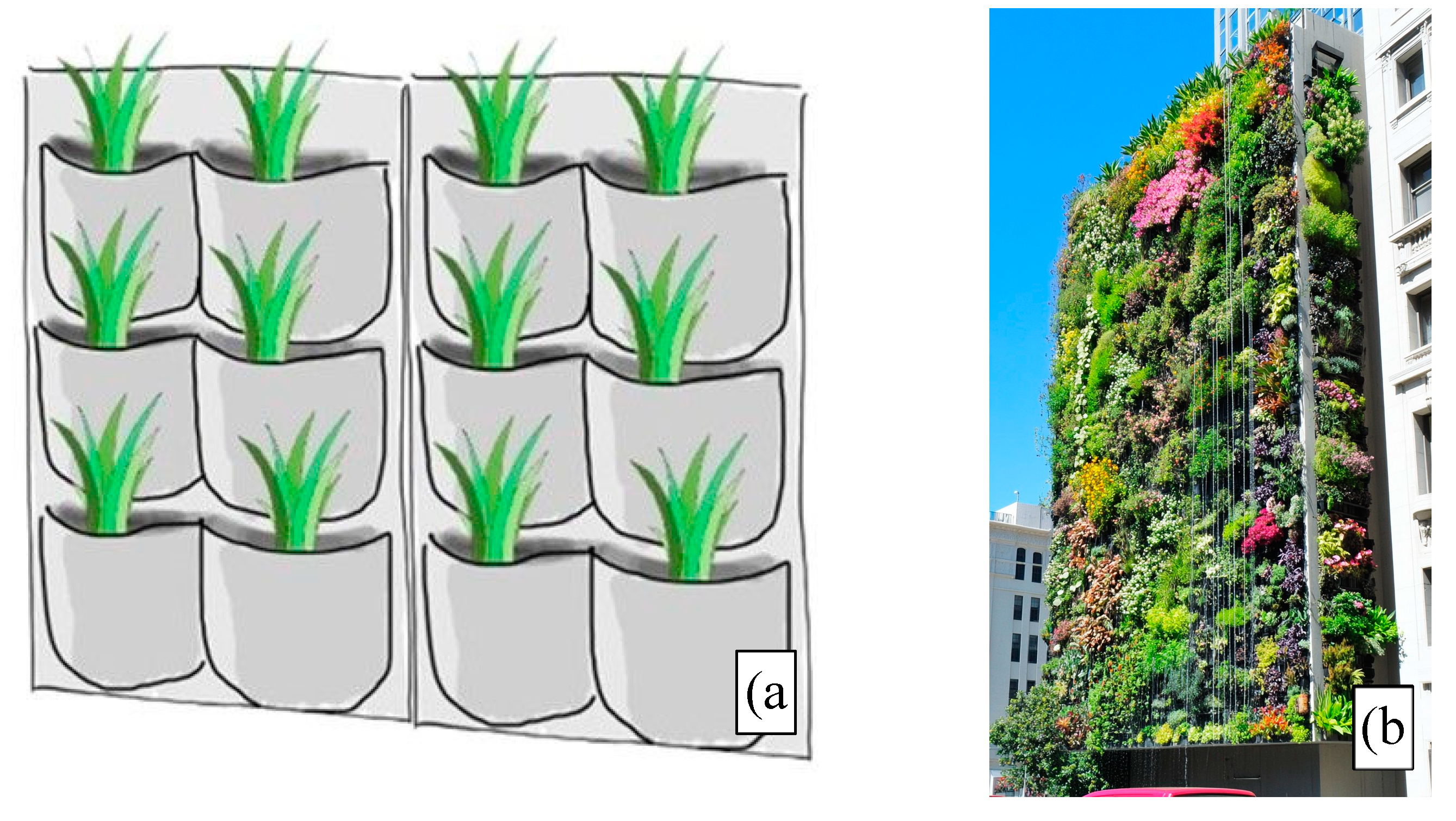
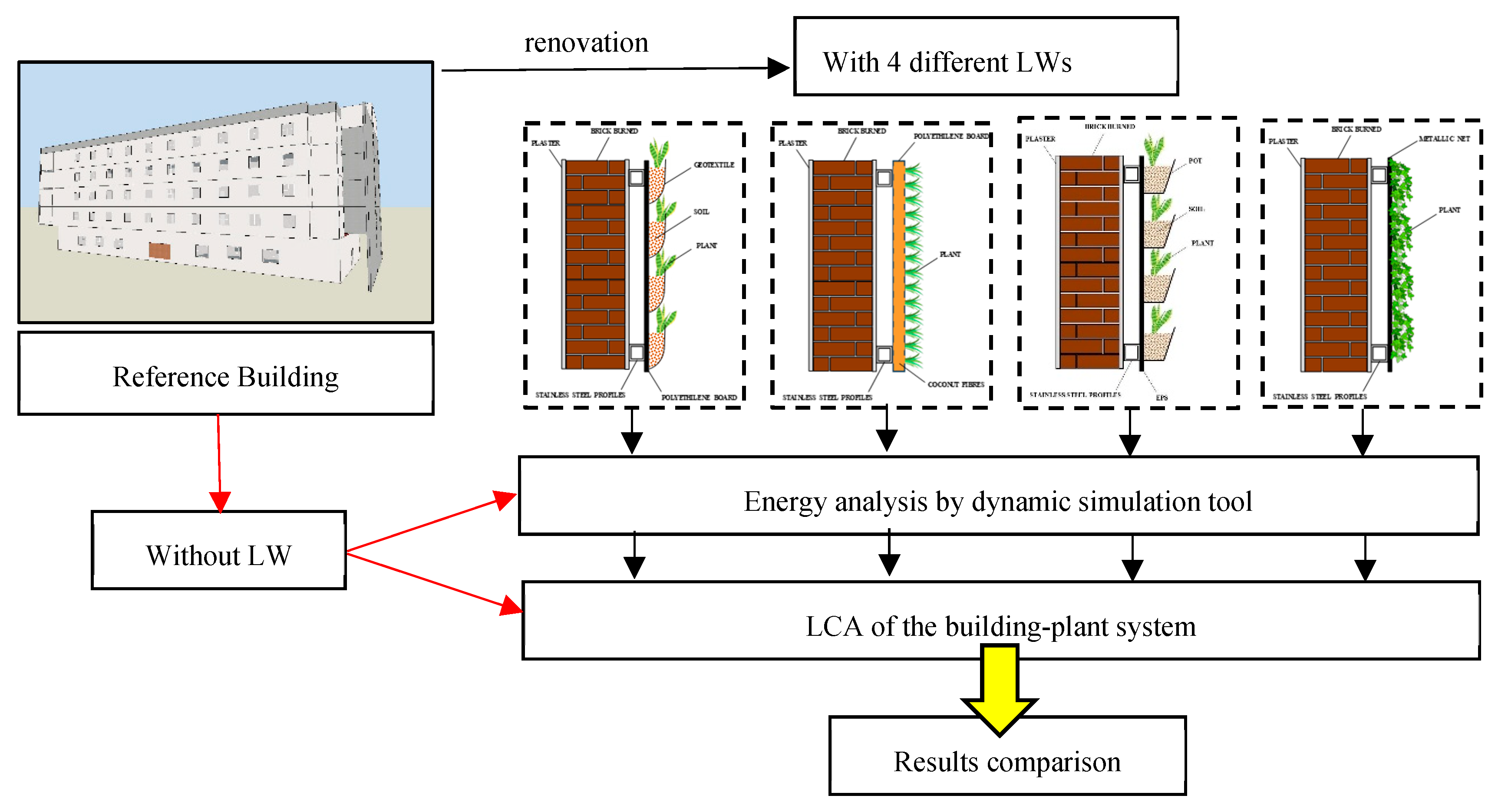

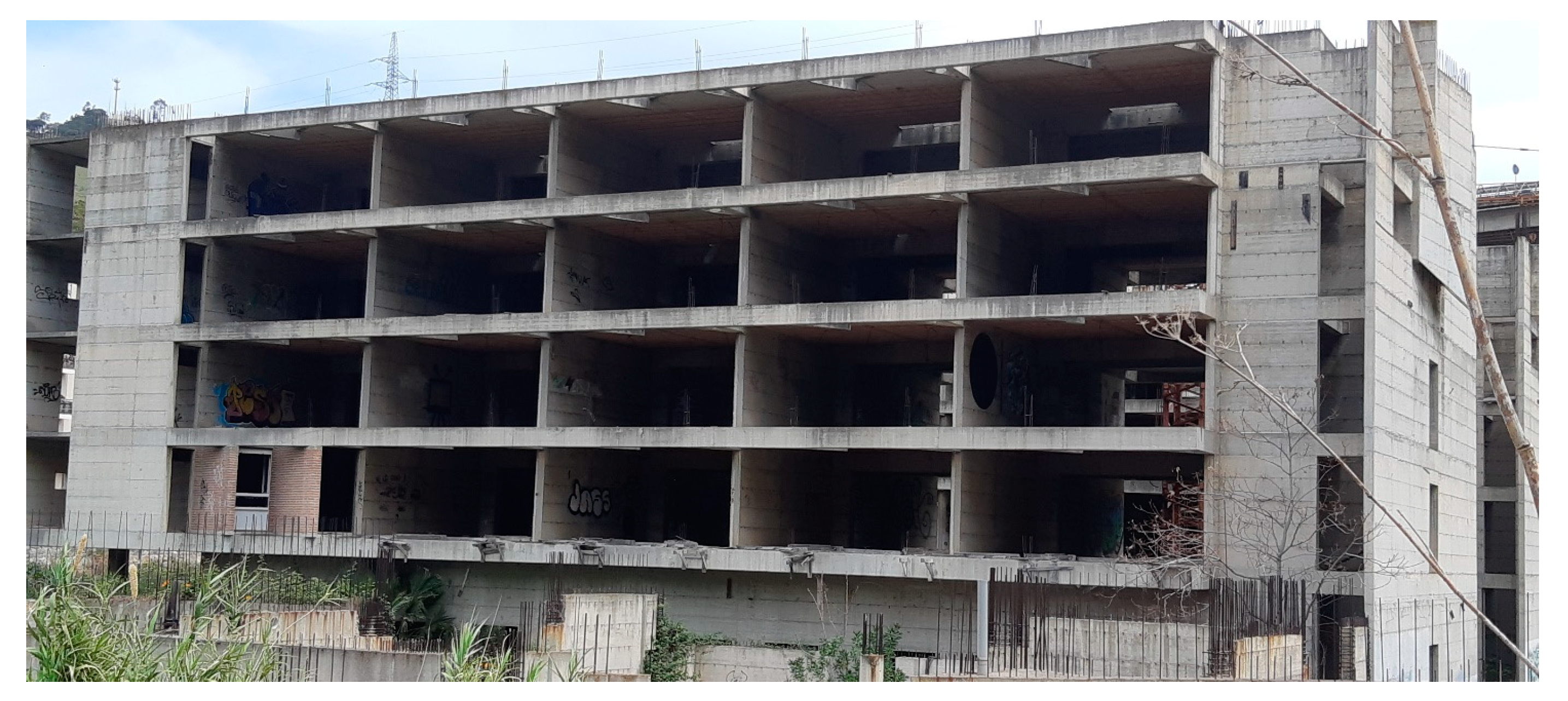
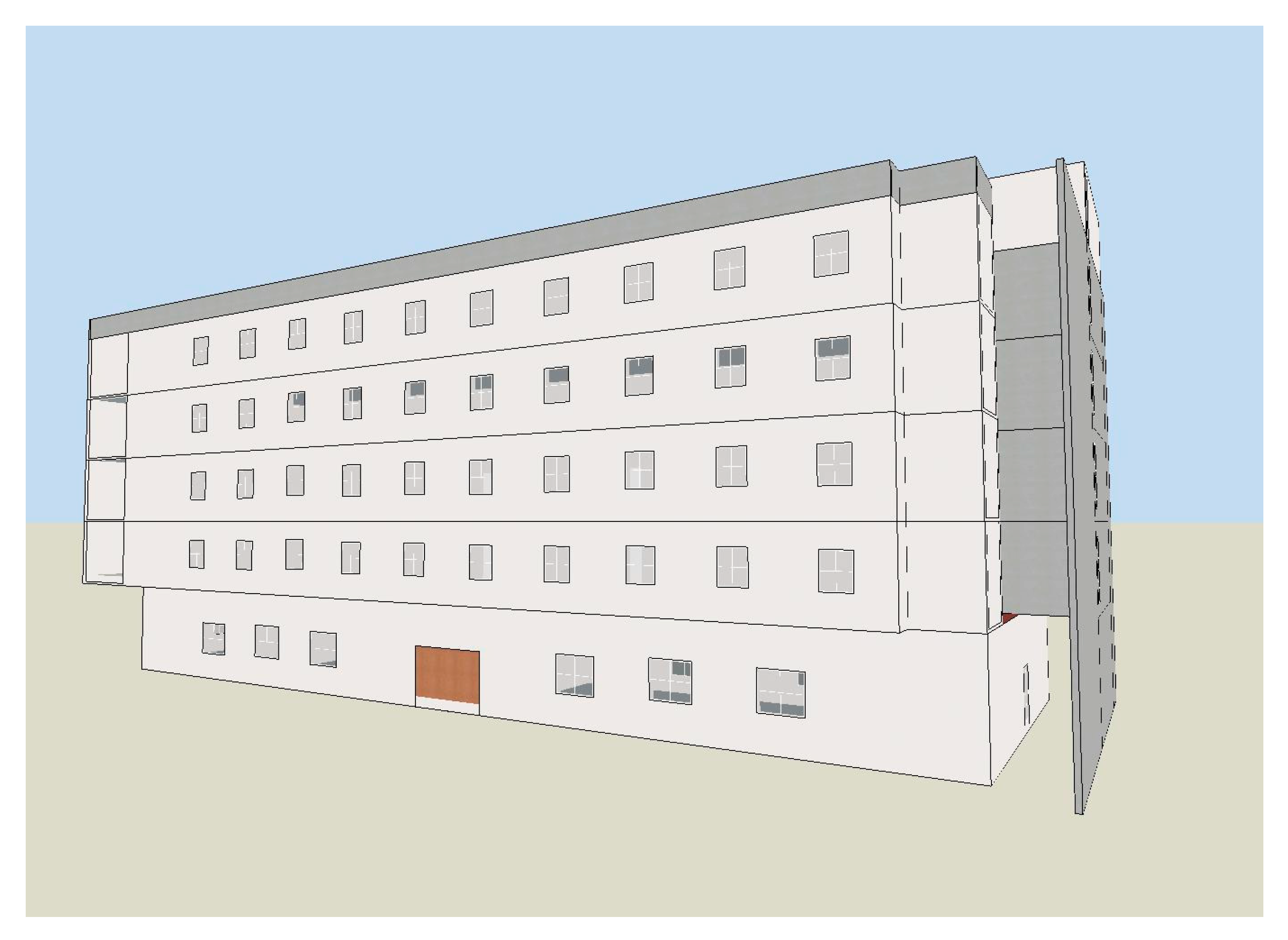

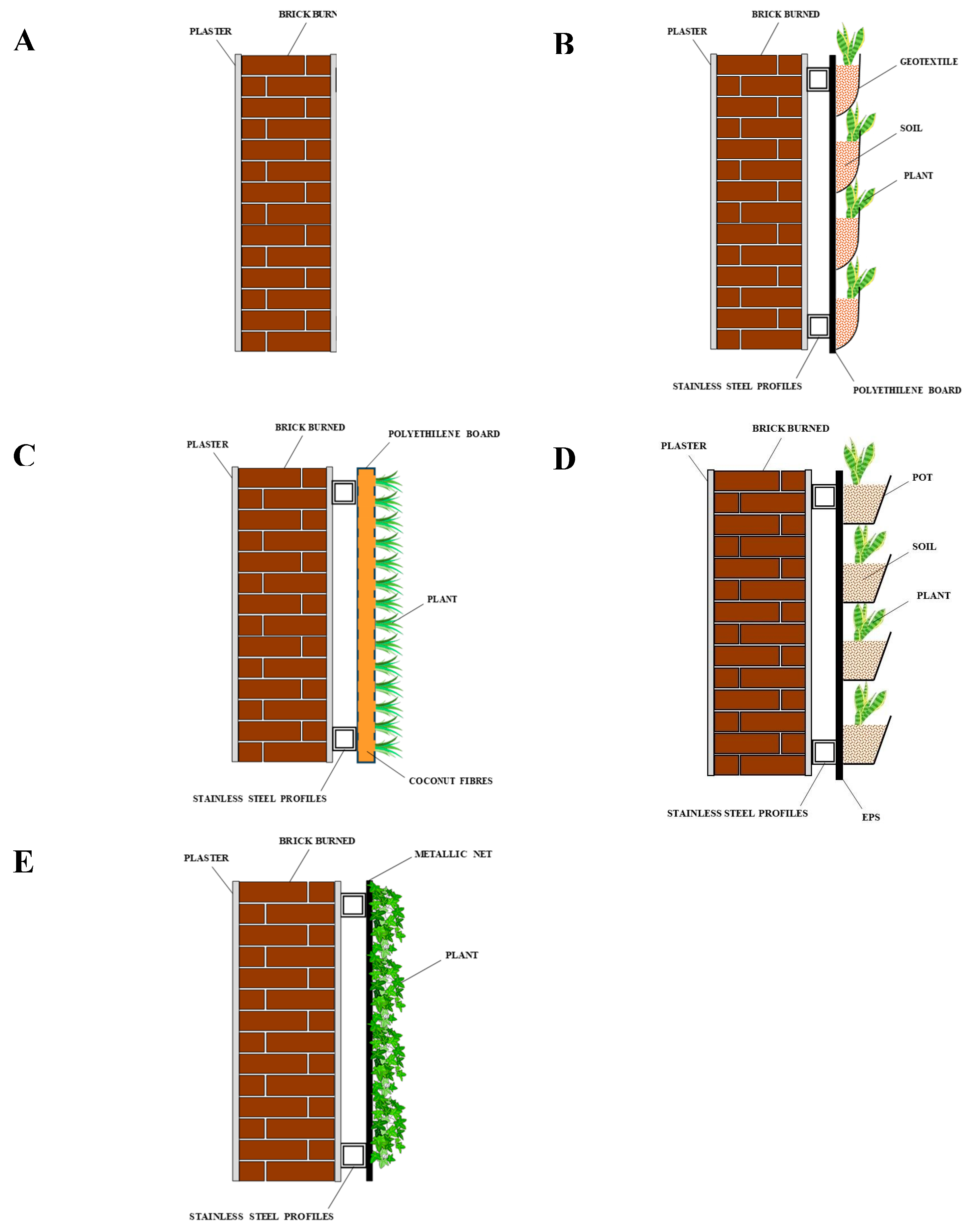
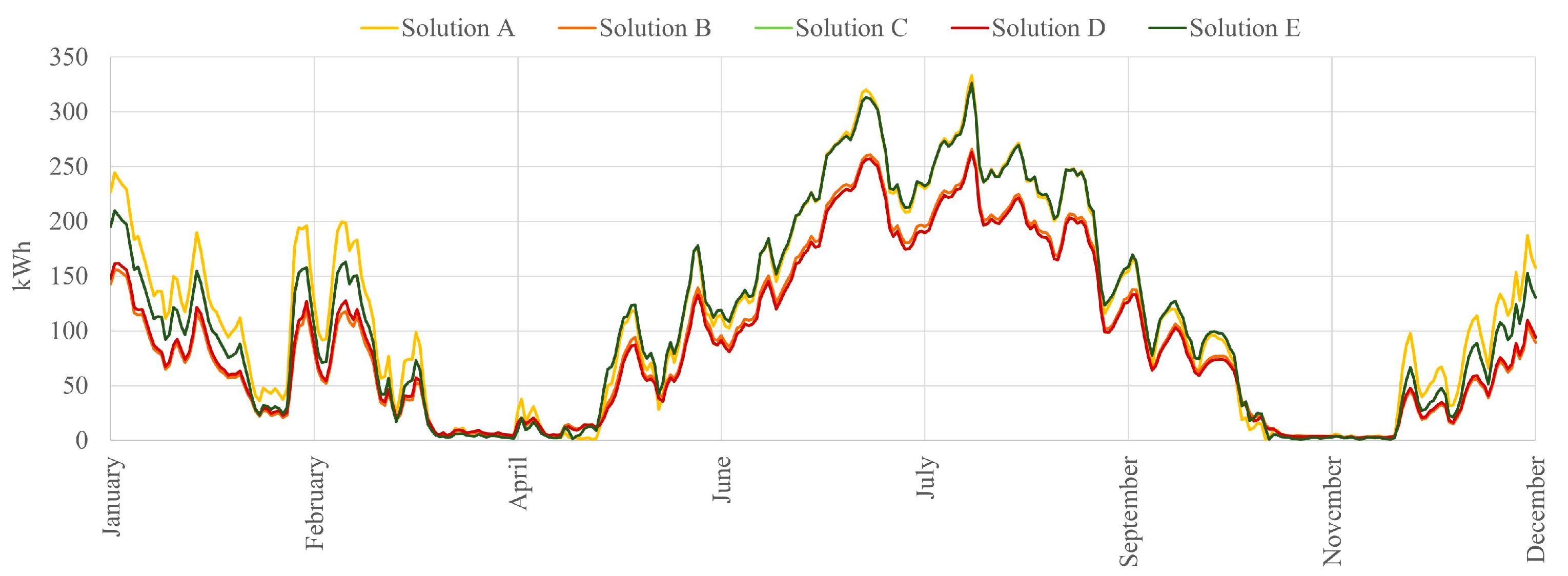
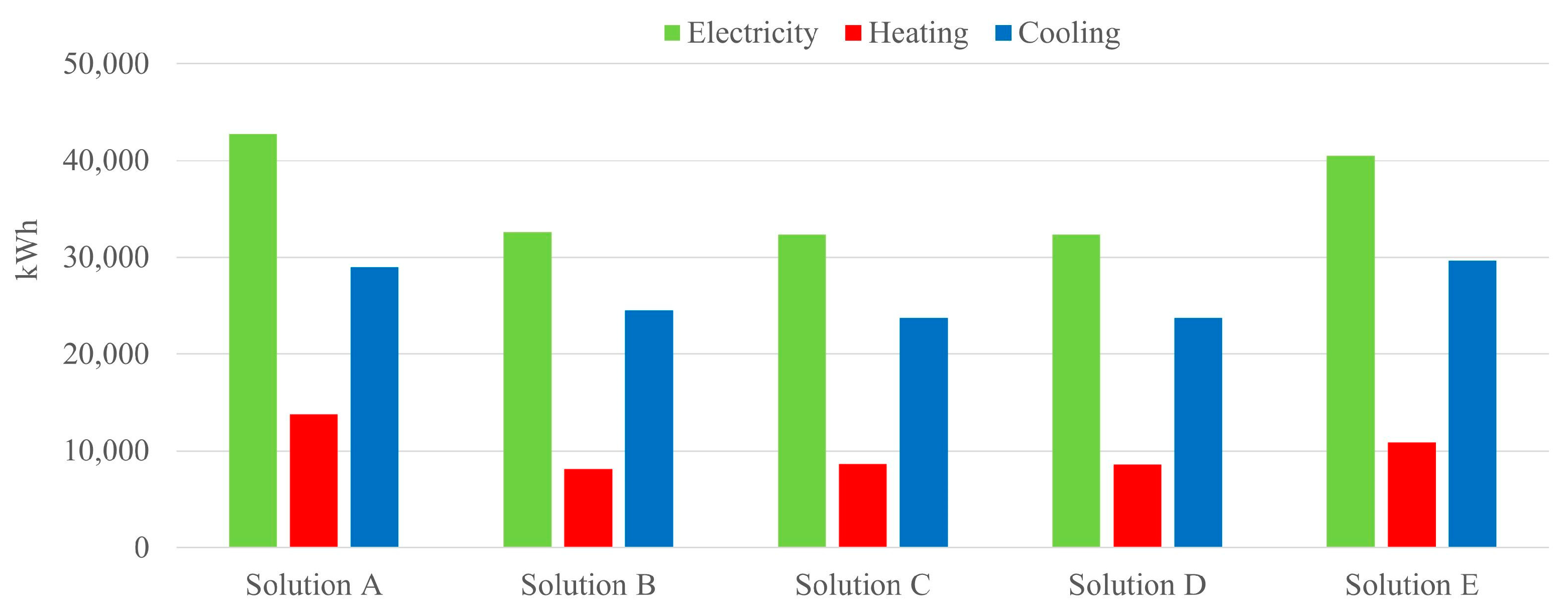
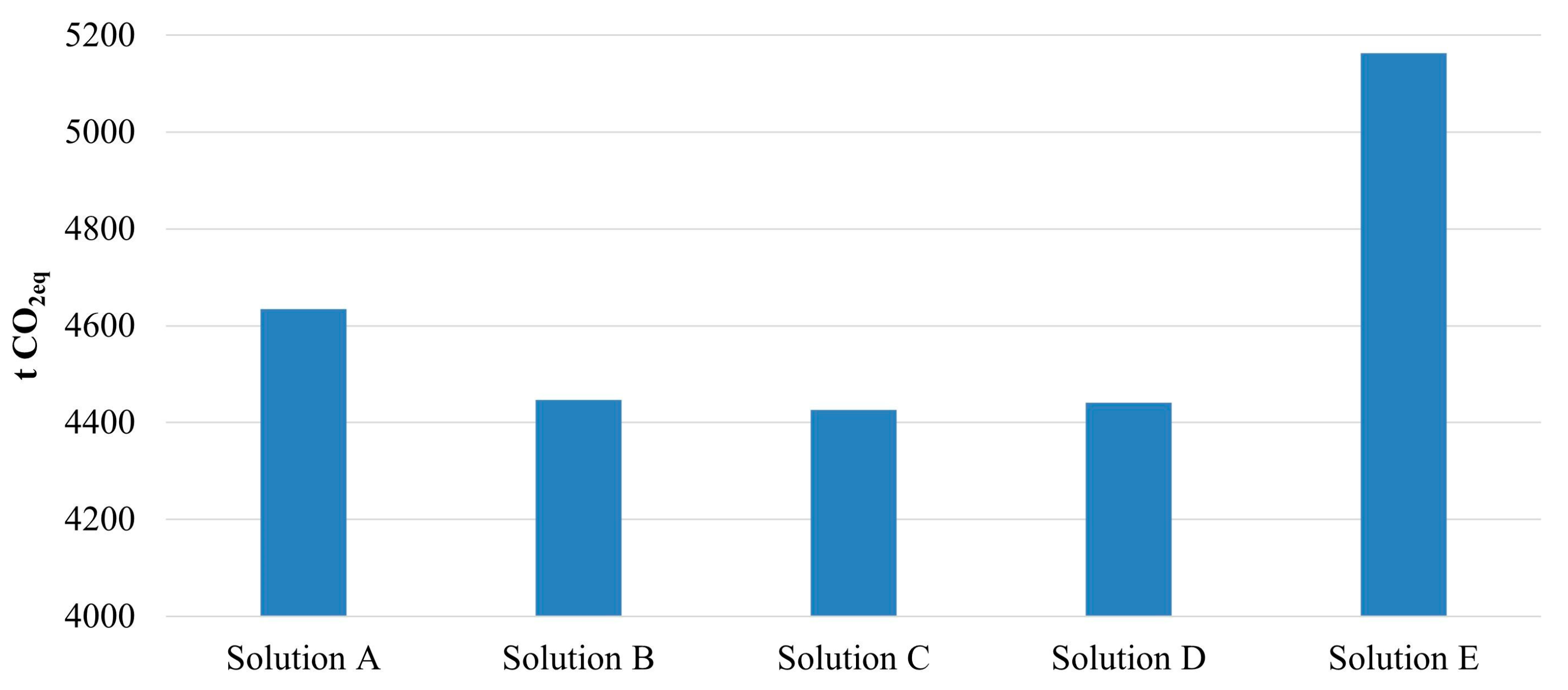
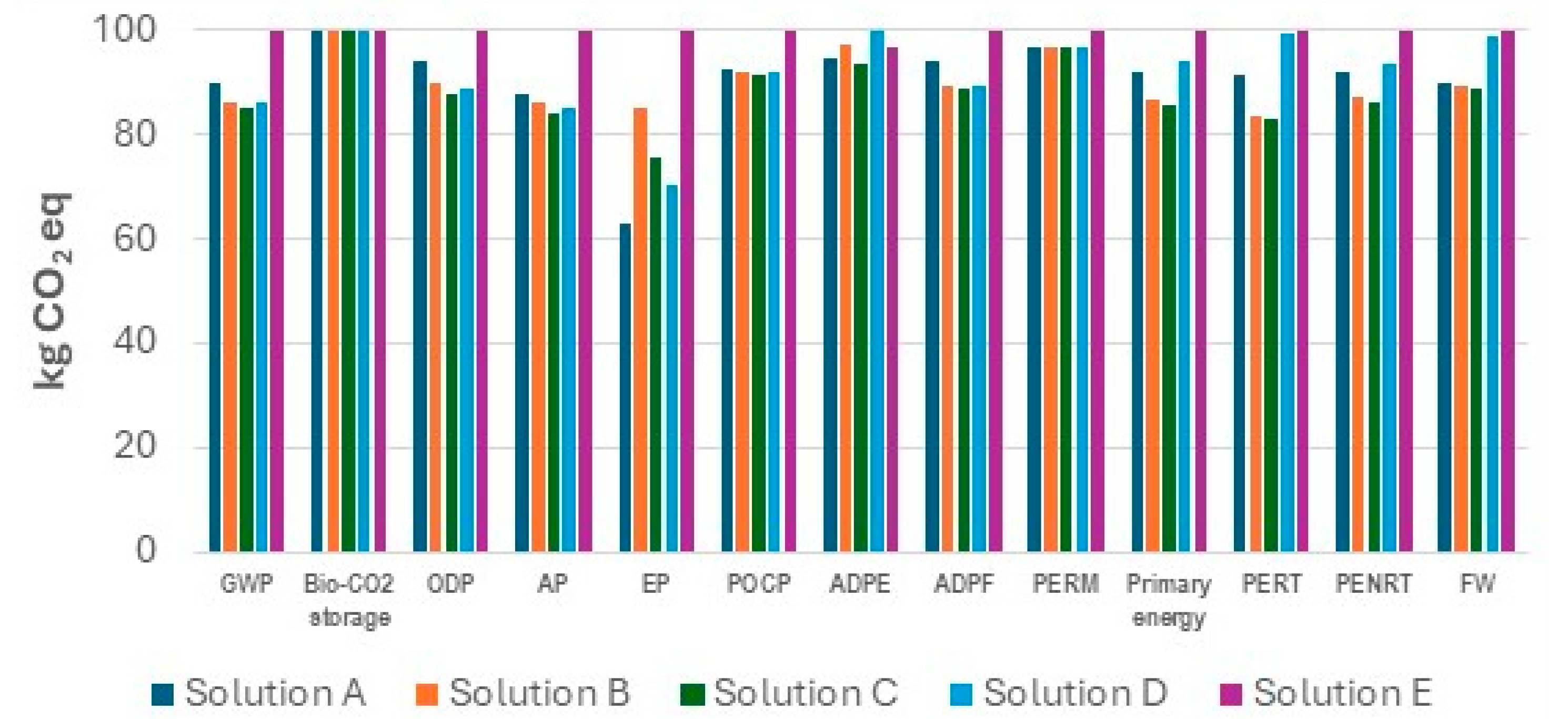
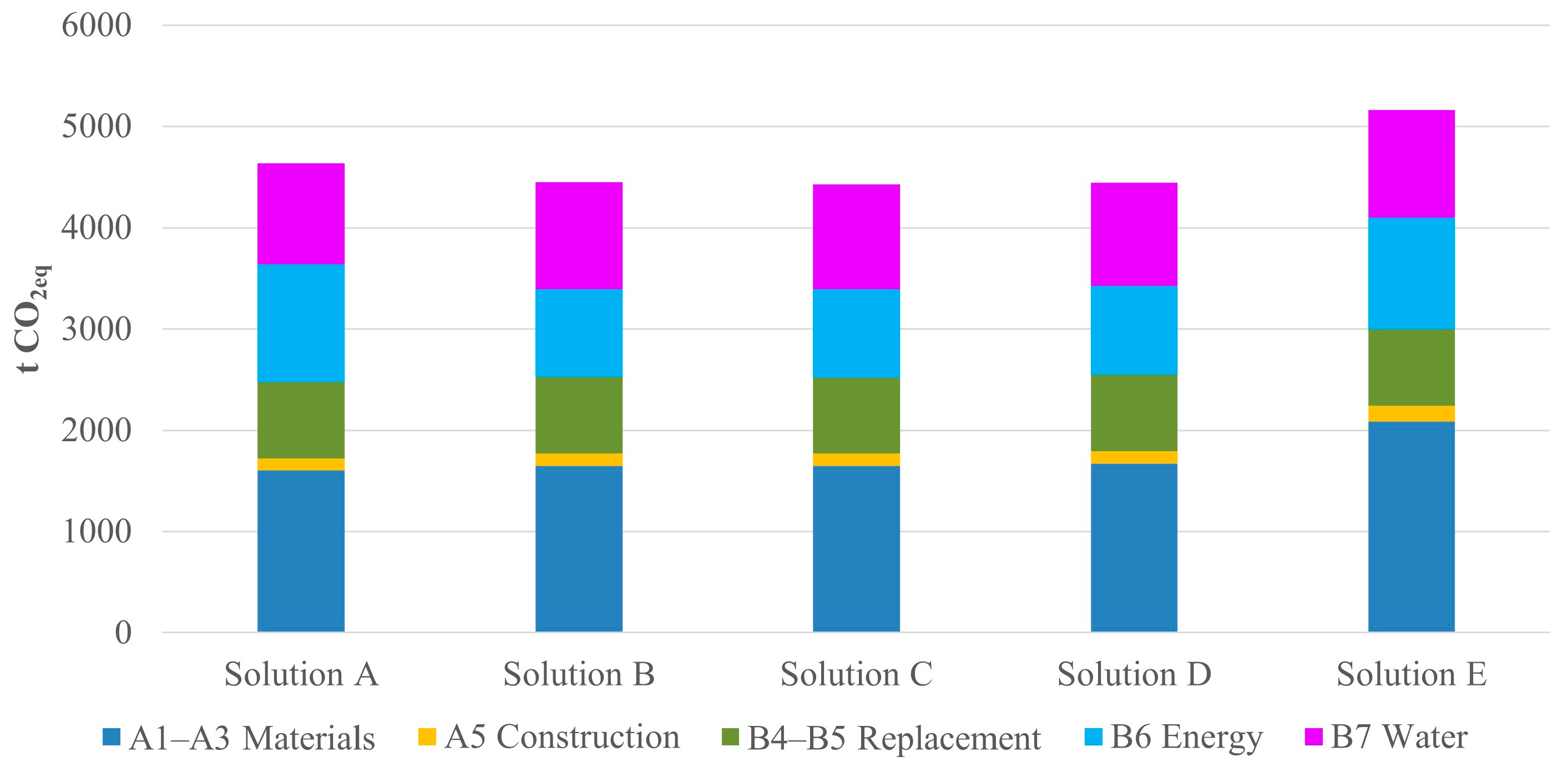
| Type | Thickness (m) | Thermal Resistance (m2·K·W−1) | U-Value (W·m−2·K−1) |
|---|---|---|---|
| Solution A (brick) | 0.30 | 0.59 | 1.70 |
| Solution A (concrete) | 0.30 | 0.40 | 2.49 |
| Solution B | 0.43 | 1.00 | 3.11 |
| Solution C | 0.43 | 1.32 | 3.07 |
| Solution D | 0.55 | 1.37 | 2.98 |
| Solution E | 0.47 | 1.15 | 3.49 |
| Solution | Materials and Equipment | Specification | Environmental Profile | Data Source |
|---|---|---|---|---|
| Solution A | Clay brick with hollow chambers | 30 mm thickness, 237.5–500 mm height, up to 1500 mm length, 42 kg/m2, 2200 kg/m3, C = 0.85 W/mk | 7.09 kg CO2e/m2 | EPD |
| Gypsum mortar | The reference product is a gypsum-based mortar. It consists of gypsum, cement and sand. | 0.17 kg CO2e/kg | EPD | |
| Solution B | Clay brick with hollow chambers | 30 mm thickness, 237.5–500 mm height, up to 1500 mm length, 42 kg/m2, 2200 kg/m3, C = 0.85 W/mk | 7.09 kg CO2e/m2 | EPD |
| Gypsum mortar | The reference product is a gypsum-based mortar. It consists of gypsum, cement and sand. | 0.17 kg CO2e/kg | EPD | |
| Geotextile felt | 312 g/m2 (1.02 oz/ft2), Composition: PP net, non-woven PE felt | 0.74 kg CO2e/m2 | EPD | |
| Aluminium rails | Extruded aluminium profiles 100% recycled content, average world aluminium manufacturing technology. 7.8 kg/m2 | 14.13 kg CO2e/m2 | EPD | |
| Polyethylene board | Polyethylene, 5 mm, 0.154 kg/m2, 30.8 kg/m3 | 4.72 kg CO2e/m2 | EPD according to ISO 14025 [36] requirements | |
| Perlite | Perlite, a volcanic mineral, as a lightweight aggregate material. Density 352 kg/m3 | 360.58 kg CO2e/m3 | Internally verified | |
| Solution C | Clay brick with hollow chambers | 30 mm thickness, 237.5–500 mm height, up to 1500 mm length, 42 kg/m2, 2200 kg/m3, C = 0.85 W/mk | 7.09 kg CO2e/m2 | EPD |
| Gypsum mortar | The reference product is a gypsum-based mortar. It consists of gypsum, cement and sand. | 0.17 kg CO2e/kg | EPD | |
| Aluminium rails | Extruded aluminium profiles 100% recycled content, average world aluminium manufacturing technology. 7.8 kg/m2 | 14.13 kg CO2e/m2 | EPD | |
| Polyethylene board | polyethylene, 5 mm, 0.154 kg/m2, 30.8 kg/m3 | 4.72 kg CO2e/m2 | EPD according to ISO 14025 [36] requirements | |
| Coconut fibres | Panels for exterior walls, L = 0.0493 W/mK, R = 8.1 m2k/W, 400 mm, 66.19 kg/m2, Lambda = 0.0493 W/(m.K) | 8.9 kg CO2e/m2. Biogenic carbon storage: 97.6 kg CO2e/m2 | EPD according to ISO 14025 [36] requirements. Self declared, bio-co2 stored. | |
| Solution D | Clay brick with hollow chambers | 30 mm thickness, 237.5–500 mm height, up to 1500 mm length, 42 kg/m2, 2200 kg/m3, C = 0.85 W/mk | 7.09 kg CO2e/m2 | EPD |
| Gypsum mortar | The reference product is a gypsum-based mortar. It consists of gypsum, cement and sand. | 0.17 kg CO2e/kg | EPD | |
| (EPS) insulation waterproof layer | L = 0.033 W/mK, R = 3.03 m2K/W, 100 mm, 3 kg/m2, 30 kg/m3, compressive strength 220 kPa, 100% recycled polystyrene, Lambda = 0.033 W/(m.K) Mass per unit: 3.0 kg/m2 | 10.31 kg CO2e/m2 | EPD according to ISO 14025 [36] requirements | |
| Planters in polypropylene | Expanded polypropylene with 30% recycled content from JSP | 1.76 kg CO2e/kg | Third-party verified (as per ISO 14025 [36]) | |
| Perlite | Perlite, a volcanic mineral, as a lightweight aggregate material. Density 352 kg/m3 | 360.58 kg CO2e/m3 | Internally verified | |
| Solution E | Clay brick with hollow chambers | 30 mm thickness, 237.5–500 mm height, up to 1500 mm length, 42 kg/m2, 2200 kg/m3, C = 0.85 W/mk | 7.09 kg CO2e/m2 | EPD |
| Gypsum mortar | The reference product is a gypsum-based mortar. It consists of gypsum, cement and sand. | 0.17 kg CO2e/kg | EPD | |
| Aluminium rails | Extruded aluminium profiles 100% recycled content, average world aluminium manufacturing technology. 7.8 kg/m2 | 14.13 kg CO2e/m2 | EPD | |
| Metallic net | Aluminium gratings, for external use, 2 mm, H = 30 mm, Mesh = 33 × 33 mm, 8.5 kg/m2 | 262.76 kg CO2e/m2 | Third-party verified (as per ISO 14025 [36]) |
| LW System | Plant Species | Water Consumption (L·d−1·m−2) | Water Consumption (m3·year−1) | Reference |
|---|---|---|---|---|
| B | Soleirolia soleiroli, Ficus pumila, Carex evergold, Vinca minor or Erodium variabile ‘Roseum’ | 4.7 | 3143 | [35] |
| C | Ophiopogon japonicus (O. japonicus) Carex appressa (C. appressa) Nephrolepis obliterata (N. obliterata) Liriope muscari (L. muscari) Myoporum parvifolium (M. parvifolium) | 3.0 | 2006 | [37] |
| D | Hardiest Perennials plants | 8.1 | 5416 | [20] |
| E | Hedera, Ivy | 5.52 | 3691 | [38] |
Disclaimer/Publisher’s Note: The statements, opinions and data contained in all publications are solely those of the individual author(s) and contributor(s) and not of MDPI and/or the editor(s). MDPI and/or the editor(s) disclaim responsibility for any injury to people or property resulting from any ideas, methods, instructions or products referred to in the content. |
© 2024 by the authors. Licensee MDPI, Basel, Switzerland. This article is an open access article distributed under the terms and conditions of the Creative Commons Attribution (CC BY) license (https://creativecommons.org/licenses/by/4.0/).
Share and Cite
Barreca, F.; Cardinali, G.D.; Bruno, R.; Arcuri, N. Sustainability Assessments of Living Walls in the Mediterranean Area. Buildings 2024, 14, 3222. https://doi.org/10.3390/buildings14103222
Barreca F, Cardinali GD, Bruno R, Arcuri N. Sustainability Assessments of Living Walls in the Mediterranean Area. Buildings. 2024; 14(10):3222. https://doi.org/10.3390/buildings14103222
Chicago/Turabian StyleBarreca, Francesco, Giuseppe Davide Cardinali, Roberto Bruno, and Natale Arcuri. 2024. "Sustainability Assessments of Living Walls in the Mediterranean Area" Buildings 14, no. 10: 3222. https://doi.org/10.3390/buildings14103222









